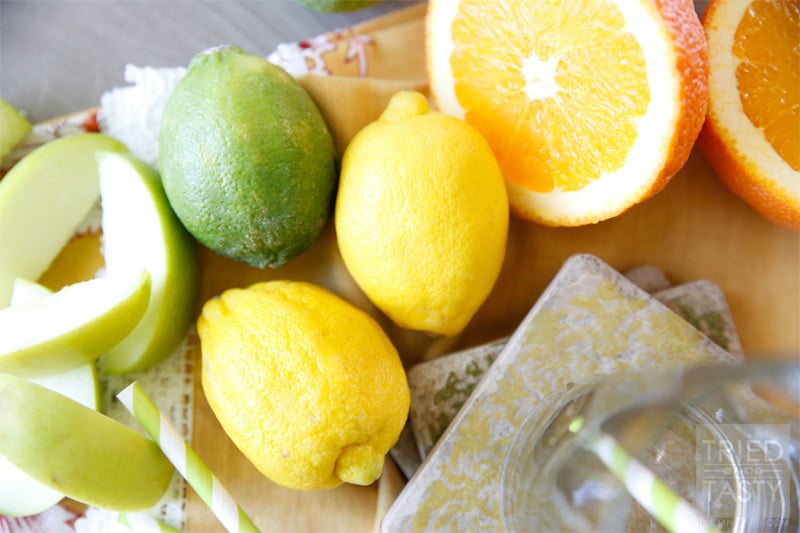I’m not the know-it-all-juice-master, but the hubs knows quite a bit. He answered most of the questions for me. Love him. One thing I want to make clear: juicing is NOT new to us. Steve and I have been juicing together since we met in 2008. Steve himself, prior to that, started about 9 years previously. So we do have a little bit of experience under our belts.
- Why is juicing so special?
Juicing allows you to condense a large plateful of healthy fruits and vegetables into a glass full of tasty liquid that you can consume in minutes. Juicing removes the fiber from the plants and this makes it easier for your body to assimilate the vitamins and minerals.
Juice is fresh and ALIVE and puts just about anything that comes in a box, bottle or capsule to shame! You can practically feel the vibrant energy in juice the second you take your first sip.
I often say that a large glass of juice likely contains more live nutrients than the average American “living” on the SAD (Standard American Diet) eats in an ENTIRE WEEK! Countless Americans fall prey to serious diseases on a daily basis and I believe that the vast majority of these diseases are due to poor diet and a lack of nutrition. Fight back with juice!
- Can’t I just eat more fruits and vegetables instead of juicing them?
Show me someone who routinely eats a plate full of four large carrots, an apple, two sticks of celery, two handfuls of spinach, a handful of parsley, a large leaf of kale, and a large collard green leaf on it, and I’ll show you someone who doesn’t need a juicer. Yeah.. that’s what I thought.
Juicing condenses large amounts of fruits and vegetables into a very manageable “delivery system”.
- Should I juice or should I blend? How Often?
I recommend doing both! Juicing delivers nutrients in a more concentrated form than blending, since there’s virtually no pulp in the juice. Juicing also allows you to consume fruits and vegetables that don’t blend very well, such as carrots, beets, and apples (due to their high fiber content). Finally, by using a low RPM juicer, you’re likely preserving more nutrients than you would by using a blender.
But on the other hand, blending a smoothie only takes about 20% of the time that juicing does and you keep all the fiber which is good for keeping your digestive tract clean and running smoothly.
I’ve found that juicing every other day (drinking half of your juice right after you make it, and the other half the next day), and blending every day can be an optimal, time efficient way to get a double dose of nutrients into your body each and every day.
- How do I store my juice?
Although it’s ideal to drink your juice as soon as possible once it comes out of the juicer, the reality is that not everyone has time to juice every day. Fear not! You can store juice in the fridge for 36-72 hours as long as you follow a few simple steps:
You’ll want to start your juicing process by placing a handful of ice cubes in your juicer’s collection container so that the juice can start cooling down immediately.
Adding a lemon, lime, or orange to your juice will not only make it taste even better, but it can also help make it last longer thanks to the citric acid from the fruit. Be sure to peel the fruit (unless you have a dedicated citrus juicer, in which case you won’t need to) before juicing it to avoid bitter juice face!
Store your juice in a glass container with an airtight lid. We use mason jars and find that they work great. Fill the container as full as possible to minimize any air in the jar before it’s sealed up.
If you have a FoodSaver system that has an accessory port on it, you can buy this nifty attachment, the FoodSaver Jar Sealer,
that sucks the air out of any wide mouth mason jar and attaches the lid to the jar with an airtight seal. It uses the standard metal mason jar canning lids, and these lids can be reused many times! I’ve been really happy with this system and suspect that it adds at least one extra day to how long the juice will store for.
- How much time will I need to commit?
You can count on spending approximately 30 minutes to make about 4 pints (2 quarts) of juice. I find that it typically takes about 10 minutes to get your ingredients together and to wash them, 10 minutes to do the actual juicing, 5 minutes to get your juice ready for storage, and 5 minutes for cleanup.
We like to run our juice through a mesh strainer to remove the bigger pieces of pulp that straggle into the juice and this can add an extra minute or two to the process.
- What do I do with all the pulp?
Most people simply throw the pulp away, since a good juicer will extract the majority of the juice from the pulp (about 70-85% of it) and there won’t be much worth saving. You can also add your pulp to a compost pile for your home garden.
- Does it taste good?
I was amazed at how much I liked the taste of juice, especially considering how many greens and healthy foods go into it. By ensuring that 25-50% of your juice is made up of sweet fruits and vegetables like apples, carrots, and beets, you’d be amazed at how well the leafy greens blend in.
There are countless recipes out there for different kinds of juice, but we love winging it and being creative. As long as you stick to the 25-50% sweet fruits and vegetables rule that I mentioned above, it’s hard to go wrong. If you’re new to juicing and very sensitive to the taste of green vegetables, you can start with an even higher percentage of sweet fruits and vegetables and gradually incorporate more and more greens into the mix until you reach that 25-50% mark.
- What do I typically juice?
Some of our favorite things to juice are carrots, beets, apples, spinach, kale, celery, parsley, cilantro, rainbow chard, collard greens, cucumber, and occasionally if we’re feeling brave, we’ll include a bit of wheat grass, which has a very strong taste but is jam packed with nutrients.
- How much does it cost to buy the juicing ingredients, and where should I buy them from?
Prices can vary by season and by what you are juicing, but you can expect to pay roughly $2 per quart of juice when using organic ingredients. A quart is an excellent amount for a typical adult to drink on a daily basis for better health and energy. Keep in mind that you can replace one of your daily meals with your juice! I can just about guarantee that it’ll be the healthiest meal you’ll ever have.
We’ve found that Costco is a great place to get organic carrots (10lbs are typically around $5.50), organic apples (which work out to be about $1.25 a pound), and organic baby spinach (which was $3.99 for a pound last time I checked).
Good Earth Natural Foods is a great place to get just about everything else. They have organic carrots, but Costco’s prices on carrots are about twice as good! Sometimes their cost on organic apples are comparable to Costco’s, and their spinach is roughly 25% more expensive than Costco’s.
- Is it important to buy organic produce?
Yes! Organic produce will save you from being exposed to toxic pesticides and I’ve seen some studies that suggest that organic produce has up to 10x more nutrients than conventional produce! This is likely because organic produce is typically grown in richer soil and given a longer time to develop before it’s harvested.
Are you interested in juicing and have questions I didn’t answer?
Leave a comment or shoot me over an email, I’d love to chat with you!
Stay tuned for my answer on ‘Juicing: Everything You Need‘ and ‘Clean 15 vs. Filthy 15: When Organic Matters‘!


